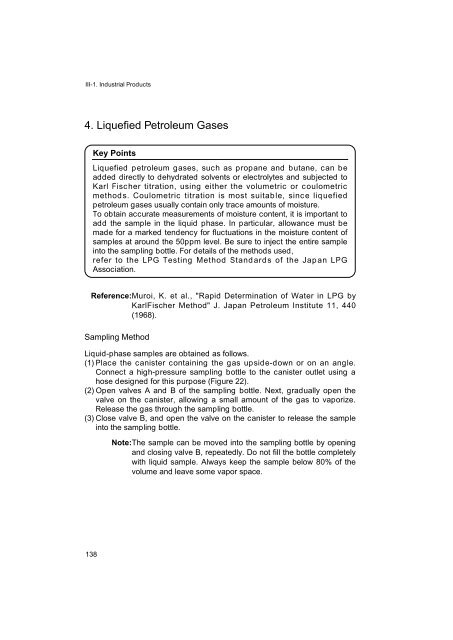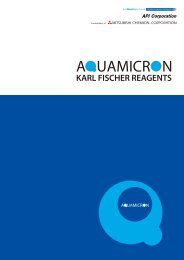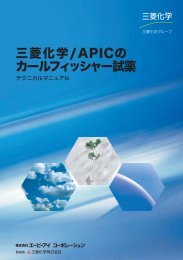Development of Karl Fischer Reagents
Development of Karl Fischer Reagents
Development of Karl Fischer Reagents
You also want an ePaper? Increase the reach of your titles
YUMPU automatically turns print PDFs into web optimized ePapers that Google loves.
III-1. Industrial Products<br />
4. Liquefied Petroleum Gases<br />
Liquefied petroleum gases, such as propane and butane, can be<br />
added directly to dehydrated solvents or electrolytes and subjected to<br />
<strong>Karl</strong> <strong>Fischer</strong> titration, using either the volumetric or coulometric<br />
methods. Coulometric titration is most suitable, since liquefied<br />
petroleum gases usually contain only trace amounts <strong>of</strong> moisture.<br />
To obtain accurate measurements <strong>of</strong> moisture content, it is important to<br />
add the sample in the liquid phase. In particular, allowance must be<br />
made for a marked tendency for fluctuations in the moisture content <strong>of</strong><br />
samples at around the 50ppm level. Be sure to inject the entire sample<br />
into the sampling bottle. For details <strong>of</strong> the methods used,<br />
refer to the LPG Testing Method Standards <strong>of</strong> the Japan LPG<br />
Association.<br />
138<br />
Key Points<br />
Reference:Muroi, K. et al., "Rapid Determination <strong>of</strong> Water in LPG by<br />
<strong>Karl</strong><strong>Fischer</strong> Method" J. Japan Petroleum Institute 11, 440<br />
(1968).<br />
Sampling Method<br />
Liquid-phase samples are obtained as follows.<br />
(1) Place the canister containing the gas upside-down or on an angle.<br />
Connect a high-pressure sampling bottle to the canister outlet using a<br />
hose designed for this purpose (Figure 22).<br />
(2) Open valves A and B <strong>of</strong> the sampling bottle. Next, gradually open the<br />
valve on the canister, allowing a small amount <strong>of</strong> the gas to vaporize.<br />
Release the gas through the sampling bottle.<br />
(3) Close valve B, and open the valve on the canister to release the sample<br />
into the sampling bottle.<br />
Note:The sample can be moved into the sampling bottle by opening<br />
and closing valve B, repeatedly. Do not fill the bottle completely<br />
with liquid sample. Always keep the sample below 80% <strong>of</strong> the<br />
volume and leave some vapor space.




